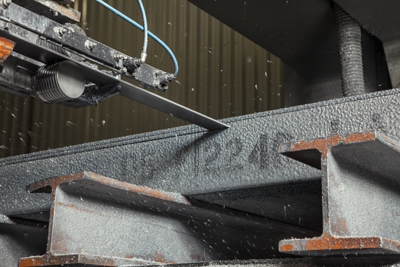
LENOX announces the release of the CAST MASTER XL band saw blade for the rigorous needs of the growing aluminum market. CAST MASTER XL is designed to provide increased blade life and superior part finish in high-speed aluminum cutting applications. With precision grinding techniques, innovative tooth geometries and next generation welding technology, CAST MASTER XL provides a quality solution for improved cutting performance on aluminum and nonferrous materials, according to the company.
"With the aluminum industry growing rapidly, there was a demand to produce a carbide tipped band saw blade that could make straight cuts at high band speeds while producing a high quality surface finish," said Daniel Fernandes, brand manager at LENOX. "A specialized grade of carbide, next generation welding technology, and precision grinding techniques allow CAST MASTER XL to cut faster and smoother while achieving increased blade life."
A primary concern when cutting aluminum is material built-up edge on the blade's tooth edge leading to premature blade failure. However, CAST MASTER XL utilizes precision grinding techniques to manufacture a higher quality surface finish on the carbide tooth edge preventing BUE. This process combined with a specialized grade of carbide that has high-wear resistance properties allows for longer blade life in aluminum and nonferrous materials.
CAST MASTER XL's aggressive rake angle increases the shear plane angle, reducing cutting forces and aiding in tooth penetration. The high-alloy backing steel and next generation welding technology prevent premature tooth loss, providing a stronger bond between the carbide tip and the backing steel, leading to longer blade life and faster cuts. CAST MASTER XL is available in a range of blade widths and tooth pitches to fit the majority of carbide-friendly band saws.
Contact Details
Related Glossary Terms
- backing
backing
1. Flexible portion of a bandsaw blade. 2. Support material behind the cutting edge of a tool. 3. Base material for coated abrasives.
- bandsaw blade ( band)
bandsaw blade ( band)
Endless band, normally with serrated teeth, that serves as the cutting tool for cutoff or contour band machines.
- built-up edge ( BUE)
built-up edge ( BUE)
1. Permanently damaging a metal by heating to cause either incipient melting or intergranular oxidation. 2. In grinding, getting the workpiece hot enough to cause discoloration or to change the microstructure by tempering or hardening.
- built-up edge ( BUE)2
built-up edge ( BUE)
1. Permanently damaging a metal by heating to cause either incipient melting or intergranular oxidation. 2. In grinding, getting the workpiece hot enough to cause discoloration or to change the microstructure by tempering or hardening.
- grinding
grinding
Machining operation in which material is removed from the workpiece by a powered abrasive wheel, stone, belt, paste, sheet, compound, slurry, etc. Takes various forms: surface grinding (creates flat and/or squared surfaces); cylindrical grinding (for external cylindrical and tapered shapes, fillets, undercuts, etc.); centerless grinding; chamfering; thread and form grinding; tool and cutter grinding; offhand grinding; lapping and polishing (grinding with extremely fine grits to create ultrasmooth surfaces); honing; and disc grinding.
- rake
rake
Angle of inclination between the face of the cutting tool and the workpiece. If the face of the tool lies in a plane through the axis of the workpiece, the tool is said to have a neutral, or zero, rake. If the inclination of the tool face makes the cutting edge more acute than when the rake angle is zero, the rake is positive. If the inclination of the tool face makes the cutting edge less acute or more blunt than when the rake angle is zero, the rake is negative.
- sawing machine ( saw)
sawing machine ( saw)
Machine designed to use a serrated-tooth blade to cut metal or other material. Comes in a wide variety of styles but takes one of four basic forms: hacksaw (a simple, rugged machine that uses a reciprocating motion to part metal or other material); cold or circular saw (powers a circular blade that cuts structural materials); bandsaw (runs an endless band; the two basic types are cutoff and contour band machines, which cut intricate contours and shapes); and abrasive cutoff saw (similar in appearance to the cold saw, but uses an abrasive disc that rotates at high speeds rather than a blade with serrated teeth).
- shear plane
shear plane
Plane along which the chip parts from the workpiece. In orthogonal cutting, most of the energy is used to create the shear plane.







